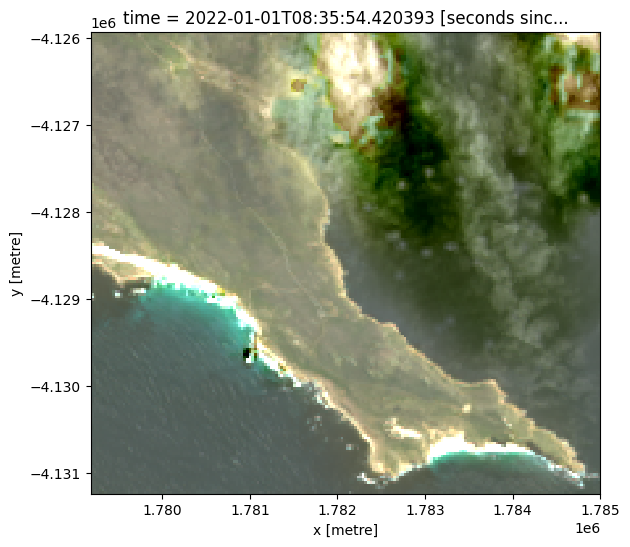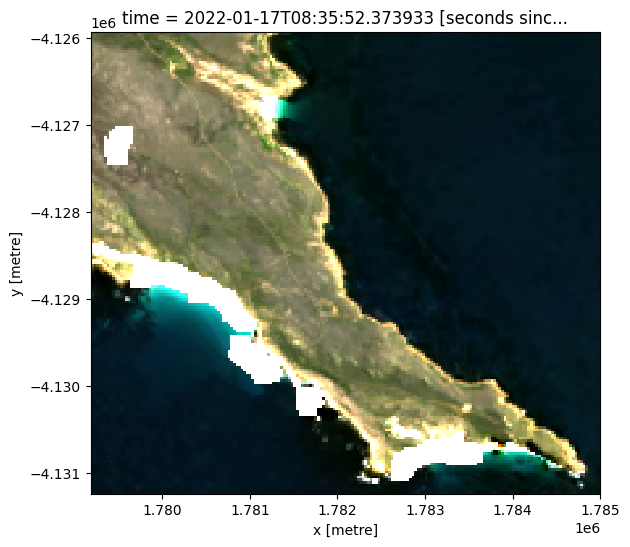Landsat Surface Reflectance  ¶
¶
Keywords data used; landsat 9, data used; landsat 8, data used; landsat 7, data used; landsat 5, datasets; landsat 8, datasets; landsat 7, datasets; landsat 5,
Background¶
The United States Geological Survey’s (USGS) Landsat satellite program has been capturing images of the African continent for more than 30 years. These data are highly useful for land and coastal mapping studies.
DE Africa’s Landsat data is ingested from the USGS Collection 2, Level 2 archive and forms a single, cohesive Analysis Ready Data (ARD) package, which allows you to analyse surface reflectance data as-is without the need to apply additional corrections.
Important details:
Surface reflectance product
Native scaling range:
1 - 65,455(0isno-data)To achieve surface reflectance values, normalise values to
0 - 1usingds = ds * 2.75e-5 - 0.2Using
dc.loadwill load data in the native scaling range1 - 65,455, while usingload_ardwill scale the values
CFMask used as cloud mask
Native pixel alignment is
centreDate-range: 1984 – present
Spatial resolution: 30 x 30 m
For a detailed description of DE Africa’s Landsat archive, see the DE Africa’s Landsat surface reflectance technical specifications documentation.
Description¶
In this notebook we will load Landsat data using two methods. Firstly, we will use dc.load() to return a time series of satellite images from a single sensor.
Secondly, we will load a time series using the load_ard() function, which is a wrapper function around the dc.load module. This function will load all the images from Landsat 5,7,8 & 9, combine them, and then apply a cloud mask. The returned xarray.Dataset will contain analysis ready images with the cloudy and invalid pixels masked out.
Topics covered include: 1. Inspecting the Landsat products and measurements available in the datacube 2. Using the native dc.load() function to load in Landsat data from a single satellite 3. Using the load_ard() wrapper function to load in a concatenated, sorted, and cloud masked time series from Landsat 5, 7, 8 & 9.
Getting started¶
To run this analysis, run all the cells in the notebook, starting with the “Load packages” cell.
Load packages¶
[1]:
import datacube
from deafrica_tools.datahandling import load_ard
from deafrica_tools.plotting import rgb
Connect to the datacube¶
[2]:
dc = datacube.Datacube(app="Landsat_Surface_Reflectance")
Available products and measurements¶
List products¶
We can use datacube’s list_products functionality to inspect DE Africa’s Landsat products that are available in the datacube. The table below shows the product names that we will use to load the data, a brief description of the data, and the satellite instrument that acquired the data.
We can search for Landsat Collection 2 Surface Reflectance data by using the search term
sr.srstands for “surface reflectance”. The datacube is case-sensitive so this must be typed in lower case.
[3]:
# List Landsat products available in DE Africa
dc_products = dc.list_products()
display_columns = ['name', 'description']
dc_products[dc_products.name.str.contains(
'sr').fillna(
False)][display_columns].set_index('name')
[3]:
| description | |
|---|---|
| name | |
| dem_srtm | 1 second elevation model |
| dem_srtm_deriv | 1 second elevation model derivatives |
| ls5_sr | USGS Landsat 5 Collection 2 Level-2 Surface Re... |
| ls7_sr | USGS Landsat 7 Collection 2 Level-2 Surface Re... |
| ls8_sr | USGS Landsat 8 Collection 2 Level-2 Surface Re... |
| ls9_sr | USGS Landsat 9 Collection 2 Level-2 Surface Re... |
List measurements¶
We can further inspect the data available for each Landsat product using datacube’s list_measurements functionality. The table below lists each of the measurements available in the data.
[4]:
dc_measurements = dc.list_measurements()
dc_measurements.loc['ls9_sr']
[4]:
| name | dtype | units | nodata | aliases | flags_definition | |
|---|---|---|---|---|---|---|
| measurement | ||||||
| SR_B1 | SR_B1 | uint16 | 1 | 0.0 | [band_1, coastal_aerosol] | NaN |
| SR_B2 | SR_B2 | uint16 | 1 | 0.0 | [band_2, blue] | NaN |
| SR_B3 | SR_B3 | uint16 | 1 | 0.0 | [band_3, green] | NaN |
| SR_B4 | SR_B4 | uint16 | 1 | 0.0 | [band_4, red] | NaN |
| SR_B5 | SR_B5 | uint16 | 1 | 0.0 | [band_5, nir] | NaN |
| SR_B6 | SR_B6 | uint16 | 1 | 0.0 | [band_6, swir_1] | NaN |
| SR_B7 | SR_B7 | uint16 | 1 | 0.0 | [band_7, swir_2] | NaN |
| QA_PIXEL | QA_PIXEL | uint16 | bit_index | 1.0 | [pq, pixel_quality] | {'snow': {'bits': 5, 'values': {'0': 'not_high... |
| QA_RADSAT | QA_RADSAT | uint16 | bit_index | 0.0 | [radsat, radiometric_saturation] | {'nir_saturation': {'bits': 4, 'values': {'0':... |
| SR_QA_AEROSOL | SR_QA_AEROSOL | uint8 | bit_index | 1.0 | [qa_aerosol, aerosol_qa] | {'water': {'bits': 2, 'values': {'0': False, '... |
Load Landsat using dc.load()¶
Now that we know what products and measurements are available for the products, we can load data from the datacube using dc.load.
In the example below, we will load data from Landsat 9 from Cape Town for South Africa in January 2022. We will load data from three spectral satellite bands, as well as cloud masking data ('qa_aerosol'). By specifying output_crs='EPSG:6933' and resolution=(-30, 30), we request that datacube reproject our data to the African Albers coordinate reference system (CRS), with 30 x 30 m pixels. Finally, group_by='solar_day' ensures that overlapping images taken within seconds of each
other as the satellite passes over are combined into a single time step in the data.
Note: For a more general discussion of how to load data using the datacube, refer to the Introduction to loading data notebook.
[5]:
# load data
ds = dc.load(product="ls9_sr",
measurements=['red', 'green', 'blue',
'qa_aerosol'],
output_crs='EPSG:6933',
y=(-34.31, -34.36),
x=(18.44, 18.50),
time=("2022-01", "2022-01"),
resolution=(-30, 30),
group_by="solar_day",
)
print(ds)
<xarray.Dataset>
Dimensions: (time: 2, y: 177, x: 194)
Coordinates:
* time (time) datetime64[ns] 2022-01-01T08:35:54.420393 2022-01-17T...
* y (y) float64 -4.126e+06 -4.126e+06 ... -4.131e+06 -4.131e+06
* x (x) float64 1.779e+06 1.779e+06 ... 1.785e+06 1.785e+06
spatial_ref int32 6933
Data variables:
red (time, y, x) uint16 8995 8851 8763 8678 ... 7172 7172 7163 7127
green (time, y, x) uint16 9122 8918 8850 8762 ... 7584 7584 7578 7518
blue (time, y, x) uint16 8176 8071 8021 7965 ... 7531 7531 7545 7516
qa_aerosol (time, y, x) uint8 160 160 160 160 160 ... 164 164 164 164 164
Attributes:
crs: EPSG:6933
grid_mapping: spatial_ref
Plotting Landsat data¶
We can plot the data we loaded using the rgb function. By default, the function will plot data as a true colour image using the ‘red’, ‘green’, and ‘blue’ bands.
[6]:
rgb(ds, index=0)

Load Landsat using load_ard¶
load_ard applies the linear scaling and offset which converts the native uint16 data to actual surface reflectance values. load_ard will additionally concatenate and sort the observations by time, and apply a cloud mask. The result is an analysis-ready dataset.
In the example below, we load Landsat 9 data for the same time and place as above. Note a cloud mask has now been applied and the data converted to decimal surface reflectance values.
This function will also load images from all the Landsat sensors if they are added to the products argument as a list.
You can find more information on this function from the Using load ard notebook.
[7]:
ds = load_ard(dc=dc,
products=["ls9_sr"],
measurements=['red', 'green', 'blue'],
output_crs='EPSG:6933',
y=(-34.31, -34.36),
x=(18.44, 18.50),
time=("2022-01", "2022-01"),
resolution=(-30, 30),
group_by="solar_day"
)
print(ds)
Using pixel quality parameters for USGS Collection 2
Finding datasets
ls9_sr
Applying pixel quality/cloud mask
Re-scaling Landsat C2 data
Loading 1 time steps
<xarray.Dataset>
Dimensions: (time: 1, y: 177, x: 194)
Coordinates:
* time (time) datetime64[ns] 2022-01-17T08:35:52.373933
* y (y) float64 -4.126e+06 -4.126e+06 ... -4.131e+06 -4.131e+06
* x (x) float64 1.779e+06 1.779e+06 ... 1.785e+06 1.785e+06
spatial_ref int32 6933
Data variables:
red (time, y, x) float32 0.04758 0.04527 ... -0.003018 -0.004008
green (time, y, x) float32 0.04888 0.04618 ... 0.008395 0.006745
blue (time, y, x) float32 0.03158 0.02806 ... 0.007488 0.00669
Attributes:
crs: EPSG:6933
grid_mapping: spatial_ref
/usr/local/lib/python3.10/dist-packages/rasterio/warp.py:344: NotGeoreferencedWarning: Dataset has no geotransform, gcps, or rpcs. The identity matrix will be returned.
_reproject(
Plot the cloud masked landsat data:
[8]:
rgb(ds, index=0)

Additional information¶
License: The code in this notebook is licensed under the Apache License, Version 2.0. Digital Earth Africa data is licensed under the Creative Commons by Attribution 4.0 license.
Contact: If you need assistance, please post a question on the Open Data Cube Slack channel or on the GIS Stack Exchange using the open-data-cube tag (you can view previously asked questions here). If you would like to report an issue with this notebook, you can file one on
Github.
Compatible datacube version:
[9]:
print(datacube.__version__)
1.8.15
Last Tested:
[10]:
from datetime import datetime
datetime.today().strftime('%Y-%m-%d')
[10]:
'2023-08-11'